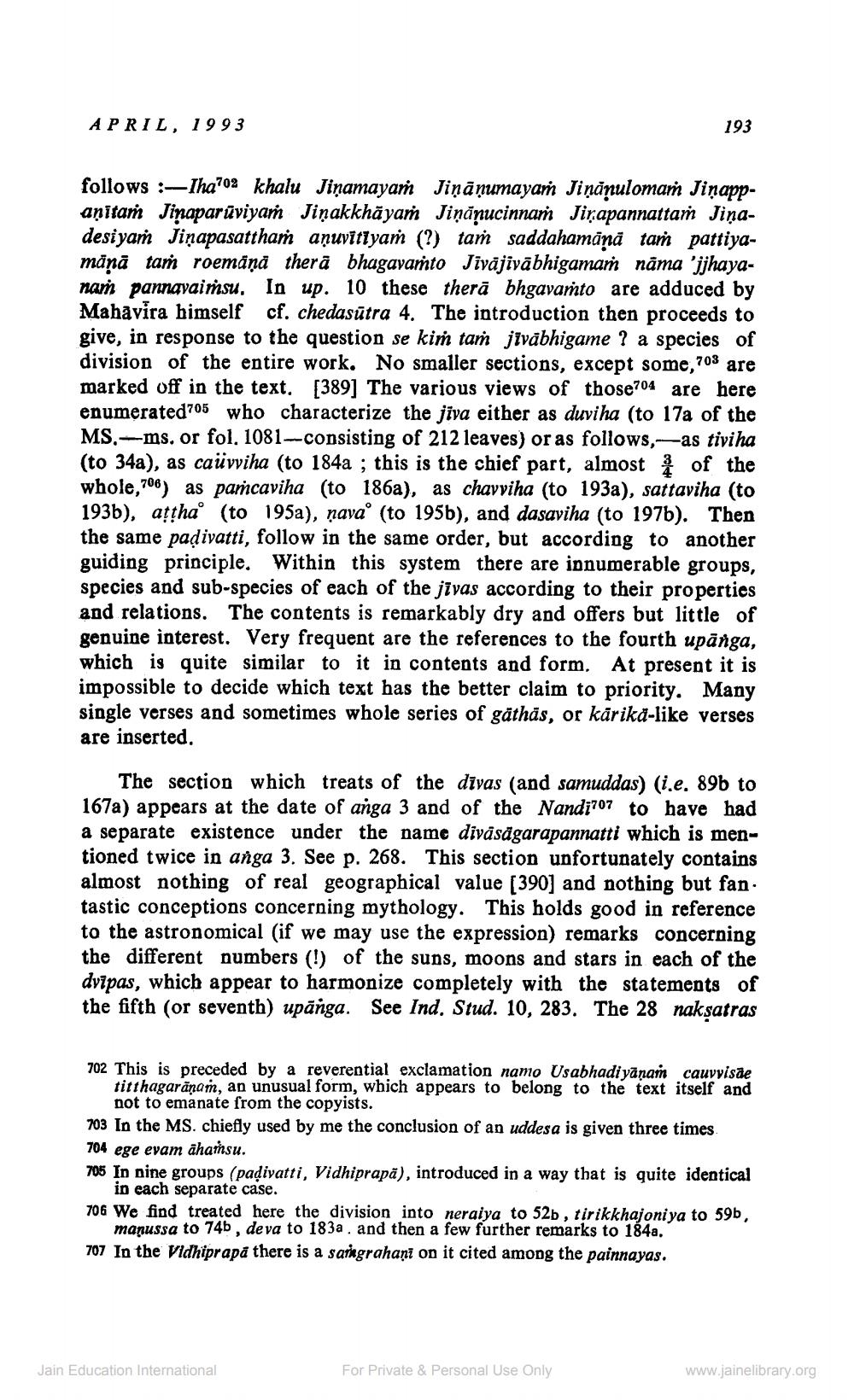________________
APRIL, 1993
193
follows :--Tha702 khalu Jinamayaṁ Jinā numayaṁ Jiņānulomam Jiņappanita Jinaparūviyaṁ Jiņakkhāyaḥ Jiņānucinnań Jiņapannattaṁ Jinadesiyam Jiņapasatthaṁ anuvītiyam (?) tam saddahamānā tań pattiyamänā tam roemäņš therā bhagavaṁto Jiväjivābhigamam nāma 'ijhayanaṁ pannavaimsu. In up. 10 these therā bhgavaṁto are adduced by Mahavira himself cf. chedasūtra 4. The introduction then proceeds to give, in response to the question se kim tań jivābhigame ? a species of division of the entire work. No smaller sections, except some, 703 are marked off in the text. [389] The various views of those704 are here enumerated705 who characterize the jiva either as duviha (to 17a of the MS, -ms. or fol. 1081-consisting of 212 leaves) or as follows, -as tiviha (to 34a), as caüvviha (to 184a ; this is the chief part, almost of the whole, 706) as pascaviha (to 186a), as chavviha (to 193a), sattaviha (to 193b), attha (to 195a), ņavao (to 195b), and dasaviha (to 197b). Then the same padiyatti, follow in the same order, but according to another guiding principle. Within this system there are innumerable groups, species and sub-species of each of the jivas according to their properties and relations. The contents is remarkably dry and offers but little of genuine interest. Very frequent are the references to the fourth upānga, which is quite similar to it in contents and form. At present it is impossible to decide which text has the better claim to priority. Many single verses and sometimes whole series of gäthäs, or kärika-like verses are inserted.
The section which treats of the divas (and samuddas) (i.e. 89b to 167a) appears at the date of anga 3 and of the Nandi707 to have had a separate existence under the name divāsāgarapannatti which is mentioned twice in anga 3. See p. 268. This section unfortunately contains almost nothing of real geographical value [390] and nothing but fan. tastic conceptions concerning mythology. This holds good in reference to the astronomical (if we may use the expression) remarks concerning the different numbers (!) of the suns, moons and stars in each of the dvipas, which appear to harmonize completely with the statements of the fifth (or seventh) upānga. See Ind. Stud. 10, 283. The 28 nakșatras
702 This is preceded by a reverential exclamation namo Usabhadiyānań cauvyisde
titthagarānam, an unusual form, which appears to belong to the text itself and
not to emanate from the copyists. 703 In the MS. chiefly used by me the conclusion of an uddesa is given three times 704 ege evam ahańsu. 705 In nine groups (padivatti, Vidhiprapā), introduced in a way that is quite identical
in each separate case. 706 We find treated here the division into neraiya to 52b , tirikkhajoni ya to 59b,
manussa to 746, deva to 183a. and then a few further remarks to 184a, 707 In the Vidhiprapa there is a saingrahari on it cited among the painnayas.
in
Jain Education International
For Private & Personal Use Only
www.jainelibrary.org




